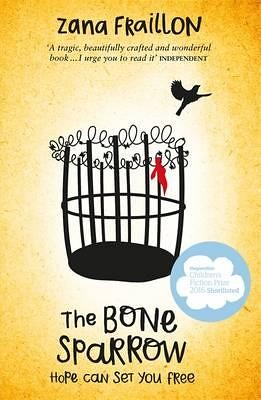She’s got some lovely fans, this author who wrote her first book in Primary 2. Lari Don has aimed to improve her next book ever since (although I’m sure the P2 book wasn’t all that bad). And I suppose because she remembers her own early start, Lari is quite happy to read what anyone in her audience has written, which is really generous. She even said she’d hand out her email address [the better to receive these works of fiction].
Lari was at Blackwells on Saturday to launch her second Spellchasers book, The Shapeshifter’s Guide to Running Away. I brought both my Photographer and the Resident IT Consultant. The latter was the first at Bookwitch Towers to read the first Spellchasers book, and he is currently ensconsed in his reading spot with the second.
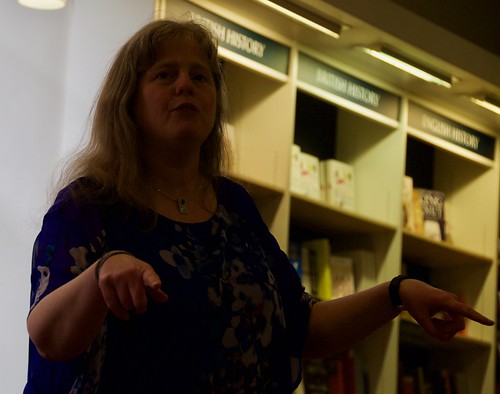
But as I said, Lari didn’t have to rely on us oldies, as she had a lovely collection of nice girls who have read and loved her books and who had lots of opinions and questions. The perfect fan audience, in fact. She got quite a bit discussed as we waited for two o’clock, thanking the fans for choosing her over the park on such a nice day (of course they would!), finding out their favourite characters, and reminiscing about a school pupil, years ago, who was started on reading by an author’s visit to his/her school.

After an introduction by Ann Landmann, who reckoned we were the right kind of audience, liking the right kind of books, even more readers arrived and everyone had to squeeze in. Lari said she’d tell us about her writing process, and then she’d tell us a story, because Ann had asked her to.
She showed us her older books, including the embarrassing (to her own children) The Big Bottom Hunt. Lari likes novels the best, and after she had made the characters in the Fabled Beast Chronicles suffer enough, she started on Spellchasers. The trilogy will end with The Witch’s Guide to Magical Combat, which is out this autumn.
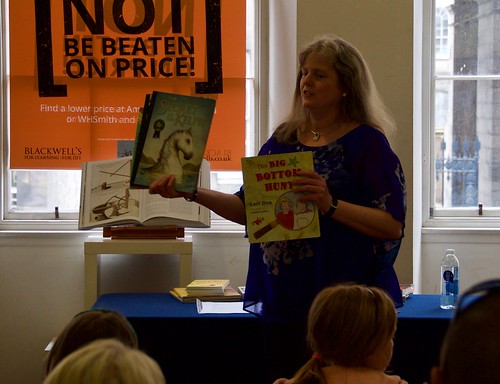
Lari read us the first page of it, which is still only in manuscript form [until later this week], and she had changed the odd thing over breakfast. Book two is about shapeshifting, so Lari asked the audience how they perceived this would look as it happens. They had a lot of ideas; eggs, smoke, eagles on top of bunk beds. That kind of thing.
As Lari began telling us the promised story, about a boy with a drum in Africa, I sort of rested my eyes a little, and the Resident IT Consultant looked as if he was asleep (I’m sure he wasn’t, really), but we both rallied when Lari requested snoring sounds, as though coming from the beast in her story… There was a monster who ate the boy’s parents and then vomited them out again. You get the idea.
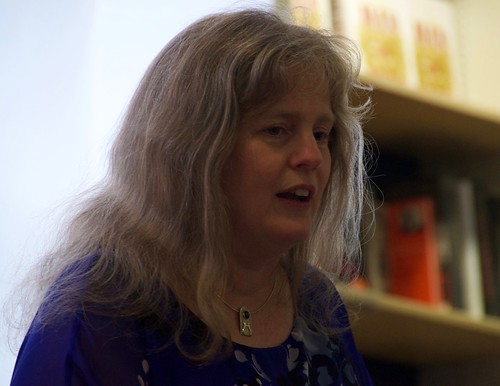
After a brief reading from the second book, we had five minutes left for Q&A. I estimate those five minutes to have lasted about 15, so that was good value. The girls had a lot of questions, but I suppose it’s to be expected from people who know that eagles need to sit on bunk beds in order to see better.
She doesn’t want to think about how many hours she uses up on writing her books. One book takes about a year, but she’s always working and hours would be too scary to contemplate, in ‘the interest of sanity.’ A brief mention of the excellence of Speyside whisky, Alan Garner and Diana Wynne Jones, and then we found out that the pre-school Lari had been quite sneaky and faked reading in bed when she was actually ‘writing’ books. Unfortunately the squiggles she wrote back then are hard to read now and she doesn’t know what the books were about.
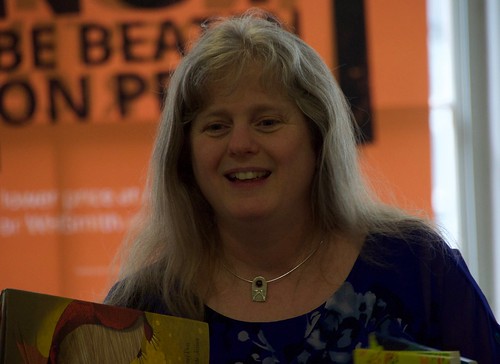
Ann Landmann finally put a stop to Lari and her fans (who simply continued talking over the book signing), after admitting she’d missed half her requested story because she’d had a customer to serve… As for us oldies, we had tea to drink in the café, and felt we really couldn’t compete for Lari’s attention with such ardent fans, anyway.

